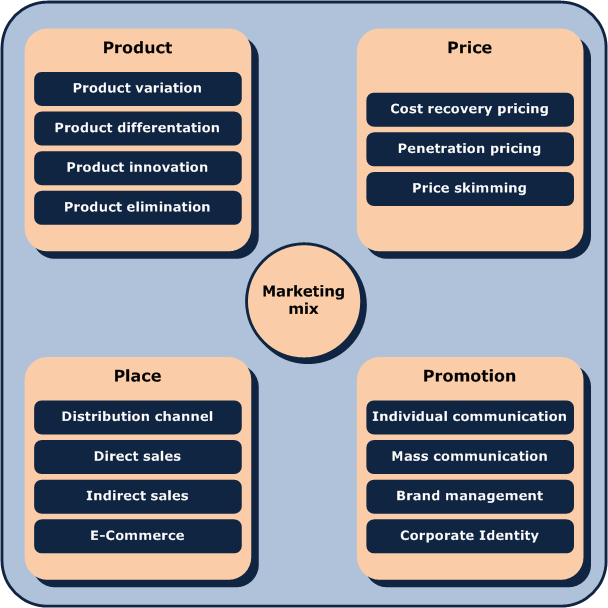Strategic Planning with the 4P's Marketing Mix Framework
4P's Marketing Mix is a technique that enables better strategic planning in business.
Applications include new product launches, repositioning existing products, and marketing strategy. The benefits of this framework are to ensure that all levers are considered and marketing strengths and weaknesses are identified and accounted for.
The traditional Marketing Mix consists of 4 P's: Product, Price, Place, and Promotion.
- Product: A tangible object or an intangible service that is mass produced or manufactured on a large scale with a
specific volume of units. Intangible products are often service based like the tourism industry & the hotel industry.
Typical examples of a mass produced tangible object are the motor car and the disposable razor. A less obvious but
ubiquitous mass produced service is a computer operating system.
- Product performance versus the competition and relative to customer expectations
- Cost relative to product line or line extensions
- Opportunities to extend the brand through new categories or to new market segments

- Price: the amount a customer pays for the product. It is determined by a number of factors including market
share, competition, material costs, product identity and the customer's perceived value of the product. The business may
increase or decrease the price of product if other stores have the same product.
- List vs wholesale price; trade margins
- Trade discounts, such as bracket discounts, terms, backhaul, and drop-ship DSD
- Product differentials, such as individual vs case, product size
- Price change policy: leader or follower, price protection, price guarantees
- Place: the location where a product can be purchased. It is often referred to as the distribution channel. It
can include any physical store as well as virtual stores on the Internet.
- Channel selection (e.g., indirect, value-added resellers)
- Customer needs and behavior, relative to place of purchase and place of use
- Promotion: Promotion represents all of the communications that a marketer may use in the marketplace.
Promotion has four distinct elements - advertising, public relations, word of mouth and point of sale. A certain amount of
crossover occurs when promotion uses the four principal elements together. Advertising covers any communication that is paid
for, from and cinema commercials, radio and Internet adverts through print media and billboards. Public relations are where
the communication is not directly paid for and includes press releases, sponsorship deals, exhibitions, conferences,
seminars or trade fairs and events. Word of mouth is any apparently informal communication about the product by ordinary
individuals, satisfied customers or people specifically engaged to create word of mouth momentum.
- Target audience
- Message and communication goals
- Timing & Scheduling
- Media (e.g., television, direct mail)
Extended Marketing Mix (5P's, 7P's)
In addition to the 4 P's marketing mix, numerous theorists have attempted to add more P's. People/Personnel is the most commonly added fifth P.Booms and Bitner extend the Marketing Mix by adding three more P's:
- People: includes employees, management and consumers, who may all add value to the final product or
service.
- Process: Procedure, mechanisms and flow of activities by which services are consumed
- Physical Evidence: The environment in which the service is delivered. Both tangible goods that help to communicate and perform the service, and the intangible experience of existing and potential customers
Other Strategic Planning Frameworks
- 4P's Marketing Mix
- Seven S (7S) Management Framework
- AIDA - Attention, Interest, Desire, Action - Buying Process
- Ansoff's Matrix - Product-Market Growth Matrix - Expansion Strategy
- BCG Growth-Share Matrix
- Bass Diffusion Model - Product Adoption and Innovation
- Blue Ocean Strategy
- Choice Model for Decision-Making Behavior
- Competitive Advantage
- Core Competence - Collective Learning in the Organization
- Cost-Benefit Analysis
- Delta Model
- ERG (Existence, Relatedness, Growth) Theory of Motivation
- Experience Curve
- Framing Effect on Psychology and Marketing
- GE (McKinsey) Matrix
- Growth Phases
- Predicting Industry Evolution and Change
- OODA Loop - Observe, Orient, Decide, Act
- PDCA (Plan, Do, Check, Act) - The Deming Cycle
- PEST Analysis - Political, Economical, Social, Technological, Environmental, and Legal Factors
- Perceptual Mapping - Brand Marketing
- Porter's Five Forces
- Product and Marketing Positioning
- Product Lifecycle (Industry Lifecycle)
- Root Cause Analysis
- SWOT Analysis - Strengths, Weaknesses, Opportunties, Threats
- Technology Adoption Curve
- Value Chain
- Balanced Scorecard
- Benchmarking
- Customer Segmentation
- Pricing Strategy & Price Optimization
- Mergers and Acquisitions (M&A)

SATISFACTION GUARANTEE
We have helped thousands of businesses with their research, and we are confident we can help you, too. We offer a 7-Day Money Back Guarantee on all purchases.

